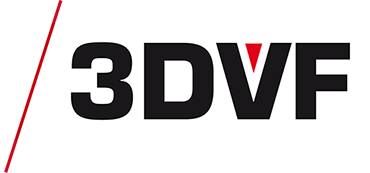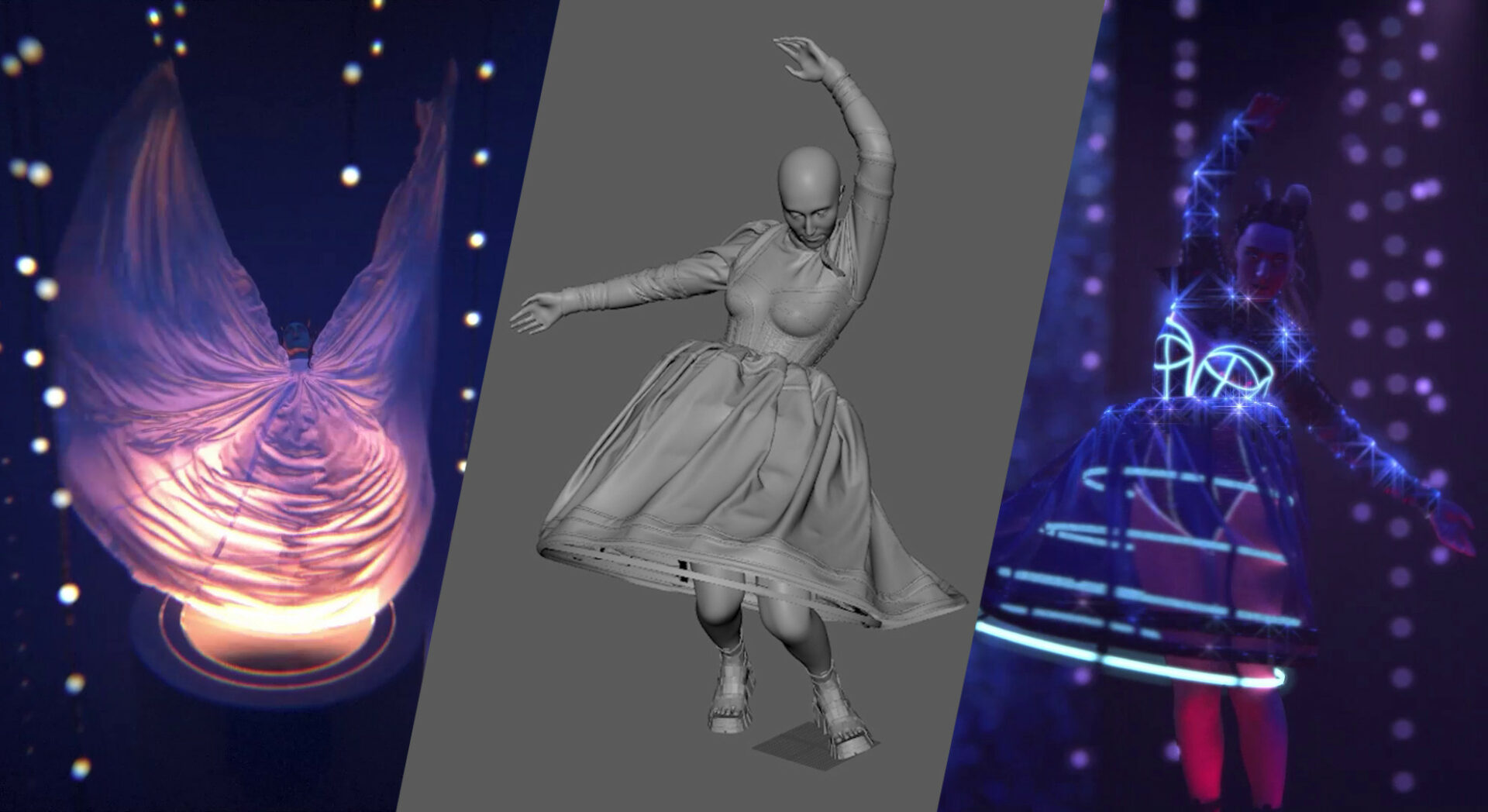This article is also available in:
![]() Français
Français
Last July, we covered the VFX-Workshop 2024 jury, which we attended. After three years of training, students unveiled their “Case Studies,” showcasing their skills.
Following our article about Nathan Dubuc’s Star Wars fan film, we now present Emma Toubin’s project, which received high praise from the jury. This unique concept blends dance, motion capture using an accessory designed by Emma Toubin, photogrammetry, simulations, and stage design.
Here’s the project, followed by an interview!
3DVF: Hi, Emma! During the VFX-Workshop final jury, you presented a project that impressed the professionals that attended the event (including the 3DVF team). Can you introduce it briefly? What were your technical and artistic ambitions?
Emma Toubin: This project showcases The Transformation, the reveal of a character in a cosmic dance. The first side of my character is called Nebula, personified by a large moving white veil that ignites and reveals Saturn, the second side, embodied by the rings of her skeletal crinoline*.
The entire project was created in CG. Three technical challenges underpinned the project:
- Creating a complex, moving, blurry silhouette in CG, draped and without structure.
- Reusing the crinoline I made for my 2021 thesis on costume-accessories for motion capture, virtualizing its movement.
- Transitioning from one silhouette to another through an FX transition.
*Crinoline: A 19th-century historical structure that shapes the volume of skirts.
3DVF: The project has two main parts: a sequence referencing Loie Fuller’s Serpentine Dance from the late 19th century, a fire transition, and a second dance with a more modern dress. How did you structure this, and what were the discussions with choreographer and dancer Louise Gagliardi? Did motion capture limit or unlock possibilities?
My brother composed the music. The tempo was key. I wanted Nebula—the first character—to begin with slow, suspended movements, while Saturn’s movements were quicker, stormy, and unpredictable. We chose a tempo of 120 bpm, allowing for both a slow dance (60 bpm) and a faster one (120 bpm), with two beats every 24 frames/second. This was very convenient for image work.

The choice of the Serpentine Dance was symbolic—it sparked my passion for costumes. Loie Fuller was one of the first to explore how costumes convey movement. Dance is often associated with the body, less with costumes. For me, costumes are an extension of the self, and I love the idea of bringing them to life to tell a story. Costume constraints create unique movements that are nearly impossible to replicate without wearing them. For the first sequence, I wanted to recreate movements from a scene in The Dancer by Stéphanie Di Giusto, while exploring different camera angles.
For the second silhouette, the crinoline was the only constraint. Using the same method as Loie Fuller, Louise improvised movements that highlighted the structure, guided by the music and the feel of the costume.
While experimenting with realistic costume simulation, I understood that motion capture was the perfect tool, provided the costume was designed thoughtfully.
In the future, I would love to work on CFX simulations with keyframe animation using a proposed style. It could be an exciting new exercise.
3DVF: Let’s talk about motion capture. It was done at a French company, Effigy, using a technical costume you designed! What does it do, and how did you design it? How was the motion capture process, and what did post-production involve?
For the optical motion capture used at Effigy, the most challenging aspect is avoiding occluding the markers during the capture process. To minimize these occlusions, the accessory suit must be limited to structured elements.
For the character Nebula, it was not possible to use a draped dress, but the character’s movements depend on such a dress. To visualize the movement of the fabric, we used rhythmic gymnastics ribbons and captured the movement of the rods. These markers were very helpful for both the dancer and the simulation, as she was instructed not to cross the rods, which prevented issues with the CFX later on.
For the character Saturn, the crinoline I made was skeletal. It was covered with a mesh that allowed motion capture markers to be placed on it to capture the movement of the hoops. Optical motion capture is better suited for solid structures. A crinoline is a semi-rigid structure. The movement of the hoops was extrapolated from the point cloud captured, using complex rigging, rotation and translation constraints, and skinning. During the retargeting phase, since the dancer was slightly shorter than me, our knees were at different heights when I transferred her body animation onto my scan. Therefore, I had to manually animate the crinoline afterward to correct the contacts with the legs.
The final virtual dance is a blend of two takes. There was a costume change on set, so we had to think about a transition in the movement that would allow us to mix the two animations. The crinoline expands, which also enables a smoother transition.
3DVF: You also had to create virtual costumes and handle cloth simulation.
What challenges did you face in that regard? Was it difficult to achieve a result that was both aesthetic and realistic?
When it comes to creating virtual costumes, the pattern-making is quite similar to what we do in real life for costumes, so it’s relatively easy if you’ve already done sewing. For the character Nebula, the amplitude of the draped fabric was a real challenge in terms of simulation. I added dynamics to the rods to smooth out the movement. I noticed during the first tests that one of the rods would rotate on itself with each arm movement. This was problematic because the fabric would wrap around the arm as the dance progressed, eventually pulling in all of the dress’s back fullness. Most of the issues encountered during the simulation stemmed from the movement source, which served as the collision base for the simulation. Significant fullness was needed to prevent the garment from flipping up due to the slightest velocity buildup in the movement.
It was difficult to manage the “wind in the sails” effect and find the right parameter to ensure the fabric wasn’t too heavy (like velvet) or too light (like tulle) and find the proper mesh density to allow for a certain scale of folds. I also wanted the fabric not to be too elastic. I often find that 3D fabrics tend to look like chewing gum. The internal skeleton of a costume isn’t often highlighted in 3D. For example, when tailoring or making corsetry, several layers are added and held in place with stitches to form rounded shapes that stiffen the costume in certain areas and allow it to wrap naturally around the body. People often imagine costumes as something soft, but the best pieces involve structural work. This was something I wanted to express in the more historical CFX that I did for the second character, Saturn. This creation was inspired by Alexander McQueen’s work, where he subverts historical structures with punk influences.
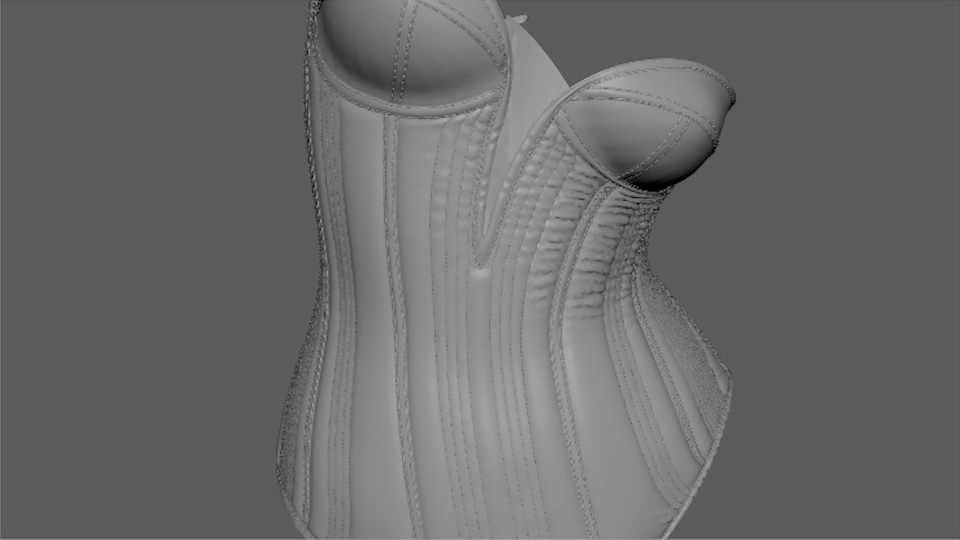
The corset’s folds are an eccentricity of mine, but I wanted to show that I could bring this level of realism with the idea of layering, which we use in corsetry. For this, I combined three different materials: first, a stiff fabric close to the body that doesn’t deform and allows for body compression, then the placement of metal boning that tensions the fabric vertically, and finally, an outer decorative fabric that is often thinner and more flexible. The interaction of these three materials creates the folds and slight tensions along the vertical axis.
For the crinoline, I captured the animated hoops through motion capture. I performed an initial cloth simulation by creating a full crinoline to have a collision layer that made it easier to simulate the overskirt. However, I designed the pattern to hide certain parts and reveal a cage crinoline.
3DVF: A few words about the transition with flames and the work on hair grooming and simulation?
The work on the dress catching fire is procedural. A good fire FX comes down to a solid source setup. To achieve this, I timed and set parameters for the fire’s spread on the fractured fabric with a ramp that allowed certain pieces to use the Vellum simulation, and others not to use it. Then, I shrunk each piece toward its centroid to give the impression of burning clothing. Finally, I used the edges of the pieces to create the fire source. I simulated the fire using the Axiom plugin in Houdini and added sparks by reusing the fire simulation’s velocity.
For the grooming of the braids, the work was entirely procedural. To simulate better collisions, I converted the curves into tubes and attached them to the character’s head. I simulated part of these tubes with a Vellum simulation (string) and used that to deform the original curves. I applied my procedural chain that creates braids from an input curve.
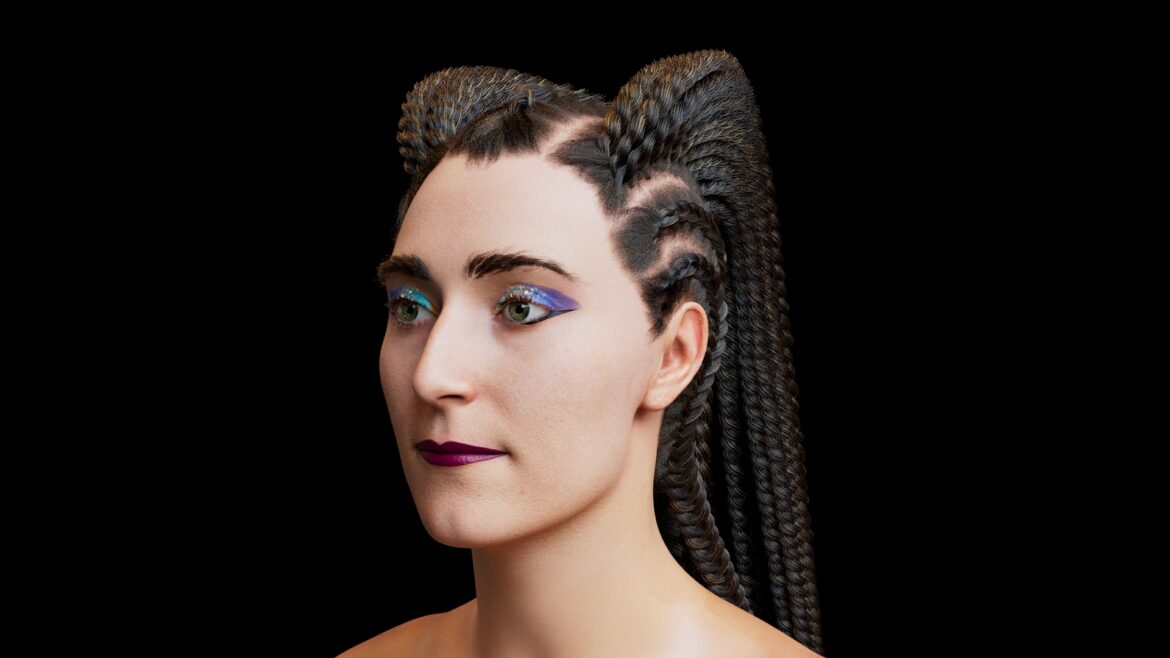
3DVF: For the human model, you chose to use 3D scanning. How did you go about it?
Effigy took photos of me using 60 DSLR cameras, with one set for the full body and another focused on the face to capture more resolution and precision in the scan. I processed these photos and reconstructed the body and face scan using Reality Capture. I made the body symmetrical but not the face. Then, I merged the more detailed head onto the symmetrical body and reprojected the proper textures. I had to clean up artifacts during the resculpt phase and refine some secondary shapes using the photos. Afterward, I wrapped several topologies from different scans to retrieve more accurate textures I was interested in, particularly some XYZ textures, and created a not-too-dense topology suited for rigging.
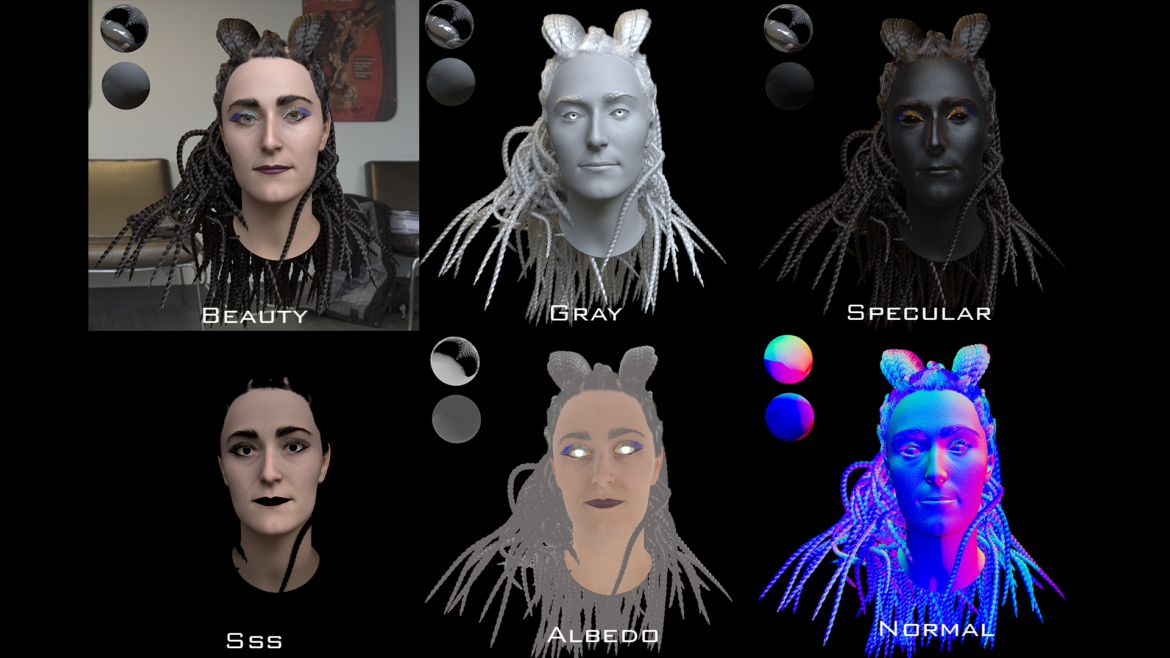
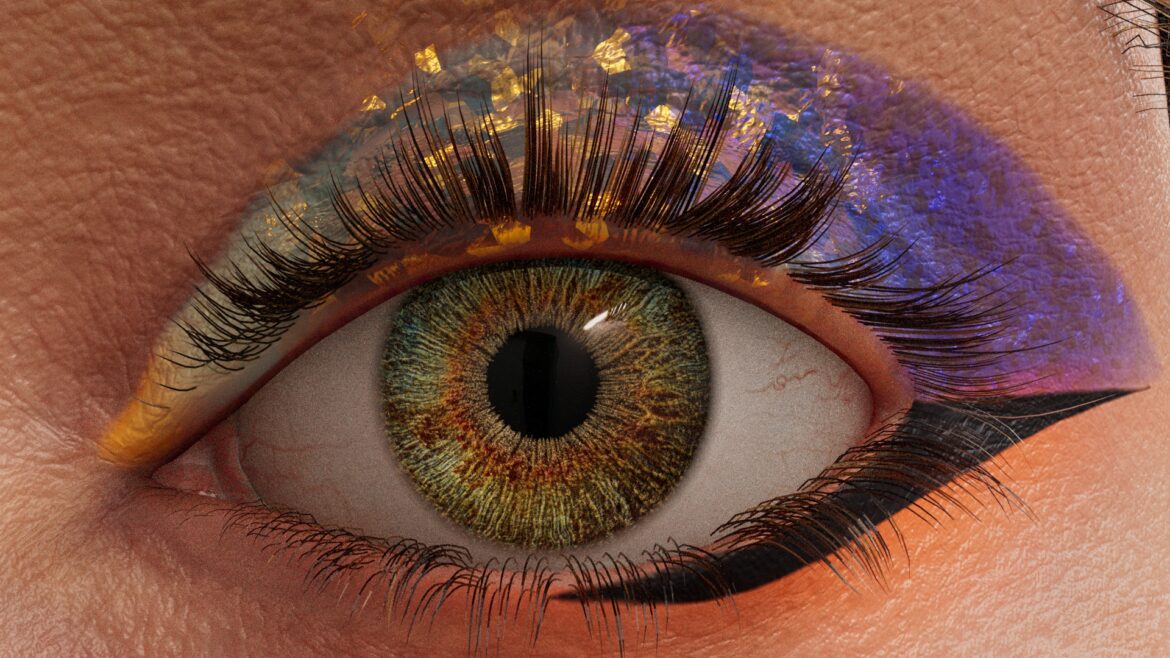
3DVF: Of course, all this work would be pointless without proper staging to showcase it. Why did you choose this direction and lighting?
I wanted to go for theatrical lighting and at the same time make the audience lose their sense of place and time.
The screens were added later. Manon Sabatier created some psychedelic visuals that were animated in sync with the music. I edited the scenes based on the different color schemes I wanted to evoke. The colors of the images projected on the screens completely influenced the lighting.
The first part is calm, with a bluish ambiance that immerses us in a starry sky. The appearance of similar harmonic changing colors shows Nebula becoming increasingly unstable. When the dress catches fire, the ambiance shifts to monochrome orange. Then the character Saturn alternates between stroboscopic whites and more lateral lighting with complementary or similar colors. Finally, Saturn stabilizes, and in the pitch-black night, only its rings are visible, illuminating the sky. We zoom out to a very dark and calm night.
I completed the lighting design in one week, and it was very effective. Thanks to the rig I built, I could control four groups of lights:
- A first group of overhead lights for texture effects (gobo).
- Two groups of overhead lights on the left and right for lateral contrast effects.
- A final group of diffused overhead lights, contrasted with an upward light from the base of the dance floor, allowing for color contrast effects.
For the rendering, I only animated the colors of the light groups. Breaking down the lighting passes during rendering, volumetric passes, and cryptomattes gave me extra control over the intensity of the light groups and allowed me to finely tune the aesthetic of my project. I really understood the power of compositing in this last project.
3DVF: The rendering step was a major challenge. Why was that, and how did you manage to complete the project on time?
Toward the end of the project, I realized I wouldn’t be able to render everything using the school’s computing power without affecting other students. I made my own luck by discussing my concerns with Renaud Jungmann, the head of VFX-Workshop, who was very responsive and put me in touch with the Progiss team [Editor’s note: partners of 3DVF who provide hardware, software and services to studios, artists and school of the animation VFX industries], who rendered my images. We weren’t entirely sure it would work because I was working with heavy Alembics, but my scenes worked well. I’m incredibly grateful to Philippe Luneau, who took care of all the rendering. His patience and efficiency allowed me to move forward calmly during the final rush period. I had one week left to composite all my shots.
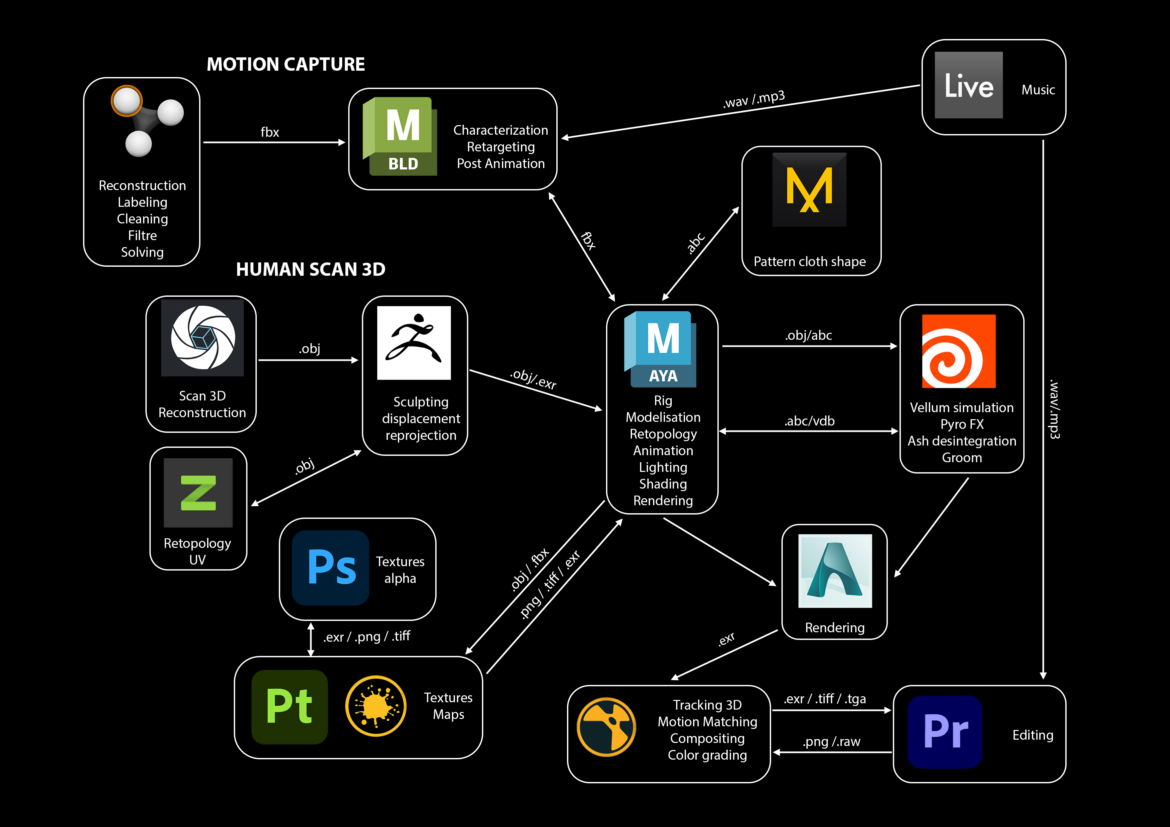
3DVF: Your project stood out to us partly because of how it aligns with your unique background at the intersection of costume design and VFX. Why this dual passion, and what has your educational path been?
I’d say my family was immersed in the arts from an early age. My sister is an actress, and my brother is a sound engineer. Since middle school, we’ve had a music group, and I’ve always made our stage outfits. Costume design has been a long-standing passion of mine, especially in cinema. I completed a science baccalaureate, followed by a preparatory course in Applied Arts at La Martinière Diderot in Lyon, and then a DNMADE Spectacle with a focus on costume design for three years. In my final year, I had the idea to focus my thesis on the impact of accessory costumes for motion capture in acting.
I reached out to Renaud, who saw the potential in the project and helped me, along with Effigy, to develop the idea further. The connection between these two fields became clear. I wanted to learn CG and explore the potential of the captured data. We had already done a few self-produced music videos with my band Brutus Yukus, and I had the idea that 3D would be useful sooner or later for creating our music videos. So, I did a second three-year course at VFX-Workshop to become a CG generalist.
3DVF: What have you taken away from this project and your time at VFX-Workshop?
That nothing is impossible, and it’s important to surround yourself with the right people. The school is a unique place for expression, and that’s the strength of VFX-Workshop. I’ve always had my own style and never felt boxed in. I allowed myself to dream big and learned what I wanted to learn.
This project has truly been a joyride. I’m very excited to enter the professional world.

3DVF: What are your future plans? Are you looking for a job at the moment?
I would love to work in cinema or TV series. I’ve been actively searching since September, looking for contracts in the CG industry but also occasionally as a costume designer or dresser to keep feeding my CFX inspiration, with the goal of merging these two fields, much like Wētā FX does.
Currently, I’m creating stage costumes with tulle prints inspired by the art of Iris Van Herpen. This time, I’m starting from CG and moving toward the real world.
Advanced tips
- Emma Toubin on LinkedIn
- Our article on the VFX-Workshop 2024 jury, and Nathan Dubuc’s Star Wars fan film project.
